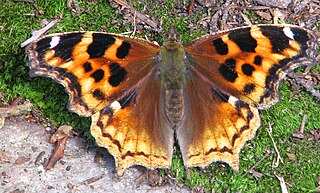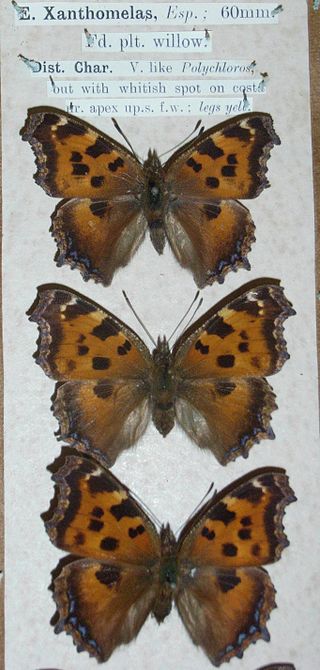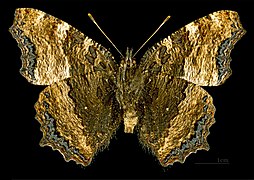
The small tortoiseshell is a colourful Eurasian butterfly in the family Nymphalidae. Adults feed on nectar and may hibernate over winter; in warmer climates they may have two broods in a season. While the dorsal surface of the wings is vividly marked, the ventral surface is drab, providing camouflage. Eggs are laid on the common nettle, on which the larvae feed.

The purple hairstreak is a butterfly in the family Lycaenidae distributed throughout much of Europe, North Africa, Anatolia, Caucasia, and Transcaucasia. The larva feeds on Quercus robur, Quercus petraea, Quercus cerris and Quercus ilex.

Apatura iris, the purple emperor, is a Palearctic butterfly of the family Nymphalidae.

Apatura ilia, the lesser purple emperor, is a species of butterfly native to most of Europe and east across the Palearctic. It is named for its similarity to the purple emperor butterfly.

Anthene emolus, the ciliate blue, is a small butterfly found in India and southeast Asia that belongs to the lycaenids or blues family. The species was first described by Jean-Baptiste Godart in 1823.

Nymphalini is a tribe of nymphalid brush-footed butterflies. Common names include admirals, anglewings, commas, and tortoiseshells, but none of these is specific to one particular genus.

Nymphalis, commonly known as the tortoiseshells or anglewing butterflies, is a genus of brush-footed butterflies. The genera Aglais, Inachis, Polygonia and Kaniska, were sometimes included as subgenera of Nymphalis but they may instead be treated as distinct genera. See also anglewing butterflies. For other butterflies named tortoiseshells, see the genus Aglais.

Nymphalis xanthomelas, the scarce tortoiseshell, is a species of nymphalid butterfly found in eastern Europe and Asia. This butterfly is also referred as yellow-legged tortoiseshell or large tortoiseshell.

Nymphalis vaualbum or N. l-album, the Compton tortoiseshell, or false comma, is a species of butterfly in the family Nymphalidae.

Catocala electa, the rosy underwing, is a moth of the family Erebidae. The species was first described by Karl Friedrich Vieweg in 1790. It can be found in Europe and Asia.

Aglais milberti, the fire-rim tortoiseshell or Milbert's tortoiseshell, is considered the only species of the proposed Aglais genus that occurs in North America.

Aglais caschmirensis, the Indian tortoiseshell, is a species of nymphalid butterfly found in the northern regions of the Indian subcontinent, primarily in the Himalayas.

Papilio ornythion, the ornythion swallowtail, is a swallowtail butterfly of the subfamily Papilioninae. It is found in Mexico and Guatemala. It is occasionally recorded from central and southern Texas and New Mexico and rarely from southern Arizona and Kansas.

Aglais rizana, the mountain tortoiseshell, is a species of nymphalid butterfly found in Asia.



















